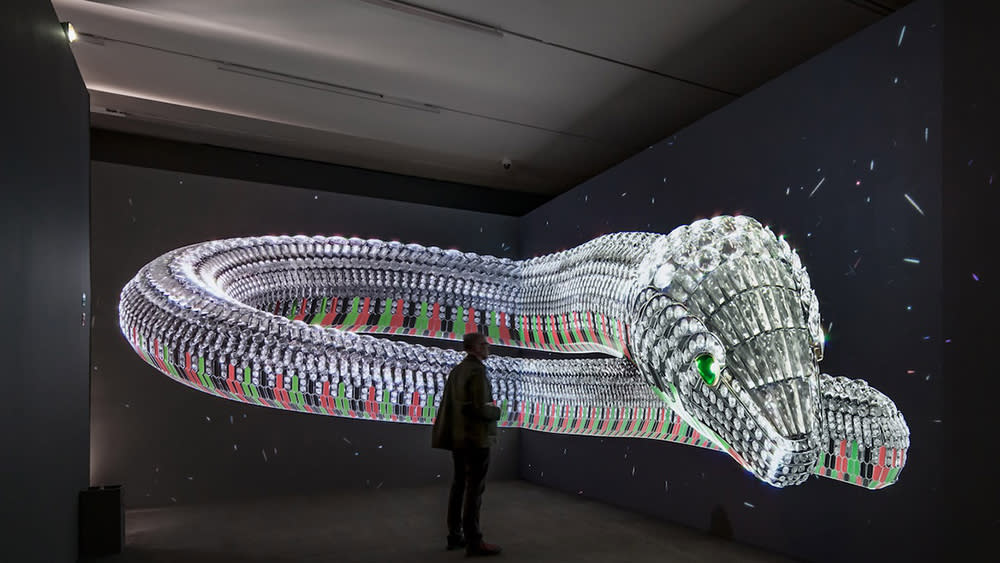Cartier’s New Exhibition in Mexico City Puts the Brand’s Wild Side on Full Display

Passionate collectors have often provoked some of the most imaginative designs. That was certainly the case with the legendary Mexican actress María Félix, who showed up at Cartier’s Paris boutique in the 1970s with a live baby crocodile as inspiration for a necklace.
From the 1950s to 1976, Félix commissioned several significant and wildly creative Cartier designs including the famous double-crocodile necklace that was covered with more than 2,000 emeralds and yellow diamonds, as well as a 22-inch-long flexible snake necklace set with over 2,400 diamonds and with its underbelly painted in red, green and black painted enamel in a nod to the Mexican flag. Those iconic designs are a highlight of the exhibition “Cartier Design: A Living Legacy,” which is on view at the Museo Jumex in Mexico City through May 14.
More from Robb Report
Richemont's New Online Platform Will Help Fight Watch and Jewelry Theft. Here's How.
Camilla Wore Queen Elizabeth's Diamond Necklace and the Greville Tiara at a State Banquet in Berlin
Worth Over $150 Million, This Epic Jewelry Collection Is Poised to Shatter Auction Records
The show puts a spotlight on Cartier’s cultural ties to Mexico and its pioneering design and craftsmanship, and pays tribute to Félix. Mexican architect Frida Escobedo, who is designing the Metropolitan Museum of Art’s new wing, created the exhibition’s immersive scenography with references to the architectural shapes of early Mexico and Mesoamerica, and the photographs that Josef Albers took of the Tenayuca pyramid in Mexico during the 1930s. Escobedo collaborated with noted Mexican curator Ana Elena Mallet, who selected 160 jewels, watches and objects from the Cartier Collection, the house’s archive of some 3,000 pieces gathered over the past 50 years.
The curator underscored the importance of jewelry as material culture and part of the human experience. “Jewelry helps us to understand people’s taste and how they lived and understand periods of time through creative materials,” explained Mallet. The exhibition opens with a diamond pyramid brooch from 1935 in a nod to Mexican archeological sites and the house’s diverse cultural influences. Walking through the cyrpt-like space, Cartier’s story unfolds in five themes—The Early Days and the Birth of a Style, Universal Curiosity, Jeanne Toussaint’s Taste, Wearing Beauty and Measuring Time and Maria Félix and Icons of Elegance.
Rather than a nostalgic look at the past, the show illustrates Cartier’s legacy as a living and evolving reference for new designers, says Pierre Rainero, the house’s director of image, style and heritage at an interview in Mexico City. In the hands of Jeanne Toussaint, the house’s creative director from 1933 to 1970, he says we see the evolution of Louis Cartier’s legacy in bold new ways. She enriched the house’s artistic styles with a sense of modernity and cultural influences from Asia, Ancient Egypt and India, all of which play into the house’s designs today. “Jeanne Toussaint’s designs were linked to a new freedom of expression for women and a new type of jewelry in terms of scale and mixing materials,” Rainero points out. That spirit gave women like Félix the inspiration to come to Cartier to execute their dreams.
Félix met many times with Toussaint, and she learned the house’s stylistic codes, and infused her own larger-than-life Mexican spirit in her special orders. She frequently wore those head-turning jewels in photographs (sometimes all at once). Those images, says Rainero, changed the jewelry landscape. “It gave people the idea of what jewelry could be, and how it could reflect themselves.”
Cartier had many muses, but as rule the house doesn’t talk about clients. It helped that Félix was so widely photographed in her Cartier pieces, and they were part of her public image. The show also showcases Gloria Swanson’s diamond, rock crystal and platinum bracelet, which she wore in the 1950 film Sunset Boulevard, the famous Flamingo brooch designed for the Duchess of Windsor in 1940, an elaborate scarab belt with an Egyptian faience created for Cole Porter in 1926, and the Santos timepiece owned by Brazilian aviator, Alberto Santos-Dumont for which it was named.
The last time that Félix’s Cartier jewels were shown in Mexico City was 24 years ago, when the house staged an exhibition at the Palacio de Bellas Artes. By then, the actress, who died in 2022, no longer owned those iconic pieces, but she was still buying Cartier jewelry, recalled Rainero. “At the last exhibit, Félix told me that she always had a taste for big jewelry, and that coming to Cartier, she was sure to get big jewelry in good taste.”
Just as Félix was inspired by Toussaint’s bold designs for her own bespoke commissions, perhaps her jewels in the exhibition will inspire the next wildly creative collaborations.
Best of Robb Report
Sign up for Robb Report's Newsletter. For the latest news, follow us on Facebook, Twitter, and Instagram.

